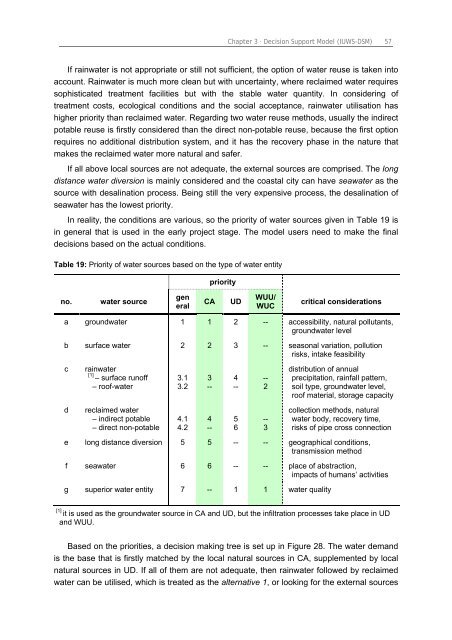Chapter 3 Decision Support Model (IUWS-DSM) - Tubdok
Chapter 3 Decision Support Model (IUWS-DSM) - Tubdok
Chapter 3 Decision Support Model (IUWS-DSM) - Tubdok
Create successful ePaper yourself
Turn your PDF publications into a flip-book with our unique Google optimized e-Paper software.
<strong>Chapter</strong> 3 · <strong>Decision</strong> <strong>Support</strong> <strong>Model</strong> (<strong>IUWS</strong>-<strong>DSM</strong>) 57<br />
If rainwater is not appropriate or still not sufficient, the option of water reuse is taken into<br />
account. Rainwater is much more clean but with uncertainty, where reclaimed water requires<br />
sophisticated treatment facilities but with the stable water quantity. In considering of<br />
treatment costs, ecological conditions and the social acceptance, rainwater utilisation has<br />
higher priority than reclaimed water. Regarding two water reuse methods, usually the indirect<br />
potable reuse is firstly considered than the direct non-potable reuse, because the first option<br />
requires no additional distribution system, and it has the recovery phase in the nature that<br />
makes the reclaimed water more natural and safer.<br />
If all above local sources are not adequate, the external sources are comprised. The long<br />
distance water diversion is mainly considered and the coastal city can have seawater as the<br />
source with desalination process. Being still the very expensive process, the desalination of<br />
seawater has the lowest priority.<br />
In reality, the conditions are various, so the priority of water sources given in Table 19 is<br />
in general that is used in the early project stage. The model users need to make the final<br />
decisions based on the actual conditions.<br />
Table 19: Priority of water sources based on the type of water entity<br />
no. water source<br />
gen<br />
eral<br />
priority<br />
CA UD WUU/<br />
WUC<br />
critical considerations<br />
a groundwater 1 1 2 -- accessibility, natural pollutants,<br />
groundwater level<br />
b surface water 2 2 3 -- seasonal variation, pollution<br />
risks, intake feasibility<br />
c rainwater<br />
[1] – surface runoff<br />
– roof-water<br />
d reclaimed water<br />
– indirect potable<br />
– direct non-potable<br />
3.1<br />
3.2<br />
4.1<br />
4.2<br />
3<br />
--<br />
4<br />
--<br />
4<br />
--<br />
5<br />
6<br />
--<br />
2<br />
--<br />
3<br />
distribution of annual<br />
precipitation, rainfall pattern,<br />
soil type, groundwater level,<br />
roof material, storage capacity<br />
collection methods, natural<br />
water body, recovery time,<br />
risks of pipe cross connection<br />
e long distance diversion 5 5 -- -- geographical conditions,<br />
transmission method<br />
f seawater 6 6 -- -- place of abstraction,<br />
impacts of humans’ activities<br />
g superior water entity<br />
7 -- 1 1 water quality<br />
[1]<br />
it is used as the groundwater source in CA and UD, but the infiltration processes take place in UD<br />
and WUU.<br />
Based on the priorities, a decision making tree is set up in Figure 28. The water demand<br />
is the base that is firstly matched by the local natural sources in CA, supplemented by local<br />
natural sources in UD. If all of them are not adequate, then rainwater followed by reclaimed<br />
water can be utilised, which is treated as the alternative 1, or looking for the external sources

















